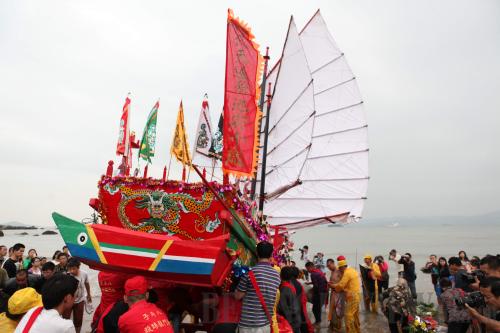|
 |
|
KEEPING TRADITION ALIVE: Fishermen from Xiamen take part in a folk ceremony on November 11, 2012 (IC) |
At the beginning of the school semester, Dr. Carolyn Bloomer, who teaches Modern China at Ringling College of Art and Design, located in Sarasota, Florida, of the United States, asks students to write down what they know about the Asian country. Two or three lines referring to the Great Wall or local food is usually all the students can come up with. Some freshmen know more and are proud of having heard of Terra-cotta Warriors and Mao Zedong (1893-1976). However, students realize that what they know is just a grain of sand after attending the class.
Besides teaching, Dr. Bloomer is the City Director for relations with Xiamen, a coastal city in southeast China's Fujian Province, at the Sister Cities Association of Sarasota (SCAS).
SCAS is part of U.S. all-nation people-to-people diplomacy network initiated in 1956. The SCAS calls for promoting peace through mutual respect, understanding and cooperation.
Jennelle Martell, Director of Programs and Grants of the Sister Cities International (SCI) says, "Japan has the most sister city partnerships with the United States. Mexico, Germany and China are actively building up similar partnerships. Our priority is to support such initiatives."
People-to-people diplomacy
The United States started sister city relationships with China in 1979. By 2012, 122 Chinese communities had established partnerships with U.S. counterparts and an average three partnerships have been set up every year over the last five.
People-to-people diplomacy provides ordinary people with opportunities to interact with overseas counterparts without the involvement of the government. Successful partnerships are often originated from common interests and similarities in geography, climate and population size.
The "people-to-people" diplomacy network has spread rapidly over the globe. Currently it comprises citizen diplomats from over 500 U.S. communities and has established partnerships with over 2,000 cities in more than 140 countries. Its activities are facilitated by the SCI headquarters based in Washington D.C.
The sister partnership between Xiamen and Sarasota was officially started in 2007.
It takes a lot of effort to build a city partnership. Siming District of Xiamen was selected as Sarasota's sister city because of the two parties' similarities. Siming is a coastal community with a sub-tropical climate featuring beautiful botanical gardens and outdoor sports. Both people like public art displays, symphony, opera and jazz while tourism contributes a lot to both economies.
Good intentions are tested by deeds. Sarasota and Siming District have proved this by having accomplished many notable projects together.
In 2009, SCAS helped Xiamen elementary schools to submit two works to an annual international competition in Sarasota called Embracing Our Differences. The event is well known around the world with up to 5,000 drawings and essays submitted every year. One Xiamen elementary school student topped the drawing contest. A $1,000 award was presented to the school principal at a ceremony.
Many SCAS members are making efforts to strengthen friendship between cities. Dr. Edward Lin is such an example.
Founder and CEO of HealO Medical, LLC and also a physician, scientist and inventor, Lin invented an advanced wound-care system, O-ACE-SysTM, which heals lesions in an efficacious and cost-effective way. In July 2012, the system won a 10-million-yuan ($1.61 million) Leading Pioneer Award from China. In the United States, HealO's O-ACE-SysTM technology will impact and shape the way $25 billion is spent annually to treat 6 million chronic wounds.
Lin said his invention will be applied to patients in sister city Xiamen.
At the end of the semester, Dr. Bloomer asked students to write what they had learned about China. This time the papers were filled with a great pool of knowledge gained in class. All students showed interest in learning more about China, the dynamic country with a long history. One student wrote, "Learning about China has been extremely eye-opening on many levels." Another student said, "I recognized learning about China's past and present has altered my view, not just on the country, but the entire world." The young people became more knowledgeable and tolerant citizens. They are to continue taking people-to-people diplomacy to new heights.
The author is a freelance writer living in New York City
Email us at: liuyunyun@bjreview.com | 